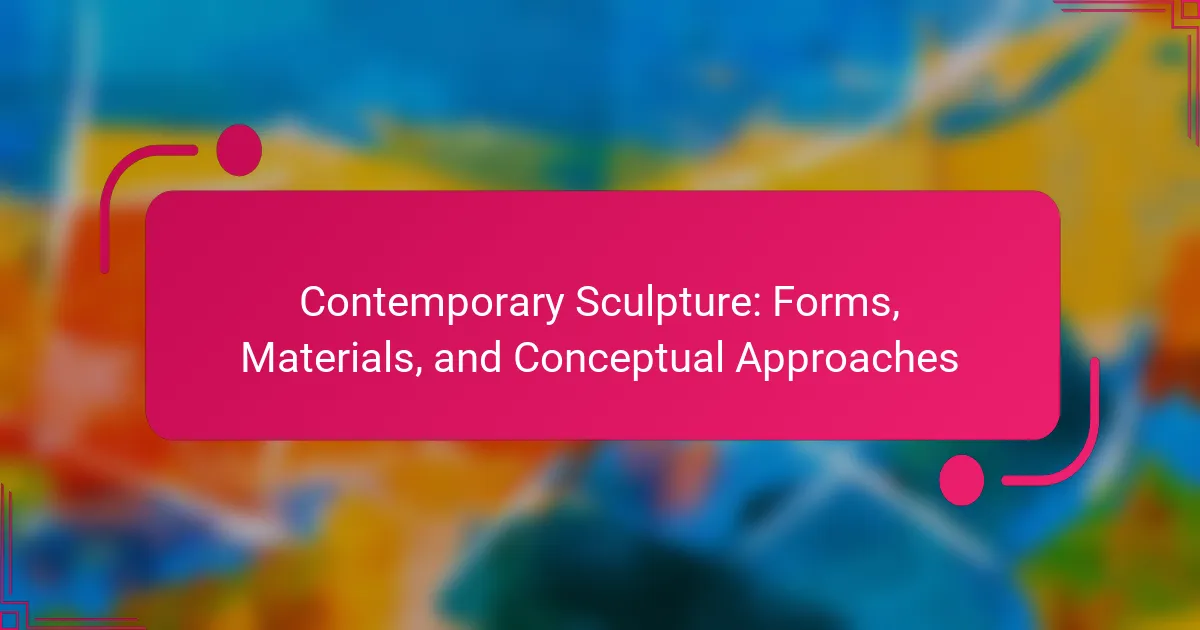Contemporary sculpture challenges traditional boundaries through innovative forms and diverse materials. Artists utilize techniques like 3D printing and augmented reality. Cultural influences shape practices, merging heritage with modern elements. Public art initiatives foster community engagement, while notable sculptors redefine the art form through unique conceptual approaches.
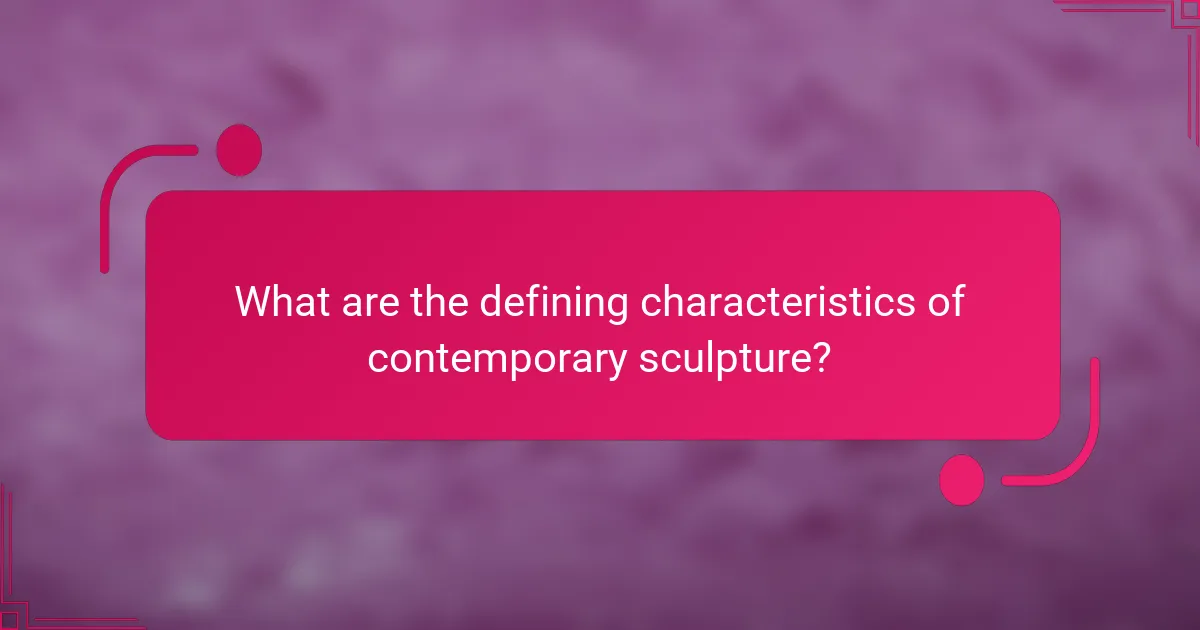
What are the defining characteristics of contemporary sculpture?
Contemporary sculpture is defined by its innovative forms, diverse materials, and conceptual approaches. Artists often experiment with non-traditional materials like found objects and digital media. Concepts in contemporary sculpture frequently challenge societal norms and provoke thought. Unique attributes include interactive installations and site-specific works that engage viewers in new ways. Additionally, the blend of technology, such as 3D printing, exemplifies the evolving landscape of this art form.
How do forms influence the perception of contemporary sculptures?
Forms significantly influence the perception of contemporary sculptures by shaping viewer interpretation and emotional response. The use of geometric shapes can evoke feelings of stability or chaos, while organic forms may suggest fluidity and naturalism. Materials like metal or glass can convey modernity, whereas wood or clay might evoke tradition. Conceptual approaches, such as abstraction or minimalism, further guide perception, inviting varied interpretations based on individual experiences. Overall, the interplay of form, material, and concept creates a dynamic dialogue between the sculpture and its audience, enhancing engagement and understanding.
What materials are commonly used in contemporary sculpture?
Contemporary sculpture commonly uses materials such as metal, stone, wood, glass, and synthetic materials. Each material offers unique properties that influence the final artwork’s aesthetic and conceptual depth. For example, metal provides durability and a modern feel, while wood offers warmth and organic textures. Additionally, innovative materials like plastics and recycled components reflect contemporary environmental concerns, showcasing artists’ adaptability and creativity.
How do conceptual approaches shape contemporary sculpture?
Conceptual approaches significantly influence contemporary sculpture by prioritizing ideas over traditional aesthetics. Artists employ diverse materials and techniques to express complex themes, often challenging viewers’ perceptions. This shift emphasizes the unique attribute of conceptual depth, where the meaning behind the work becomes as important as its form. As a result, contemporary sculptures often provoke dialogue and reflection, showcasing a rare fusion of art and philosophy.
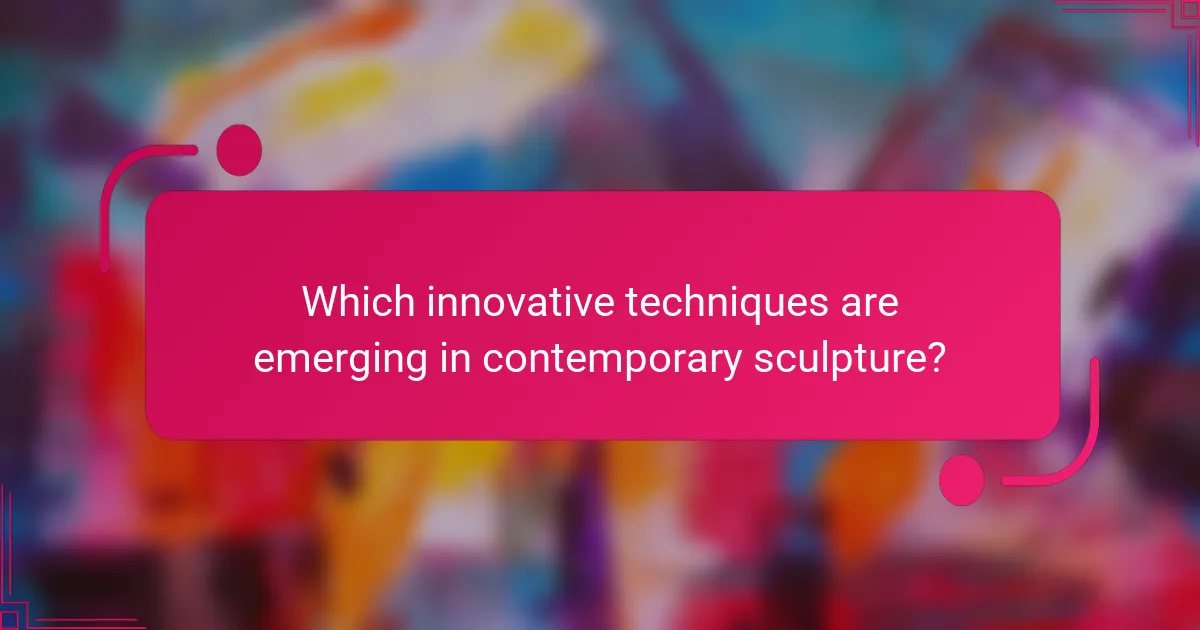
Which innovative techniques are emerging in contemporary sculpture?
Innovative techniques in contemporary sculpture include the use of digital fabrication, augmented reality, and eco-friendly materials. Artists increasingly utilize 3D printing to create intricate forms that were previously impossible. Augmented reality allows viewers to interact with sculptures in new dimensions, enhancing the experience. Additionally, sustainable practices are gaining traction, with artists incorporating recycled materials and biodegradable substances, reflecting a commitment to environmental responsibility. These approaches redefine the boundaries of sculpture, merging technology and sustainability with traditional practices.
How does technology impact the creation of contemporary sculptures?
Technology significantly enhances the creation of contemporary sculptures through innovative materials and techniques. Artists now utilize digital tools like 3D modeling software, enabling precise designs that were previously unattainable. Advanced materials, such as biodegradable plastics and responsive metals, offer new expressive possibilities. Techniques like CNC machining and 3D printing allow for intricate details and complex forms, transforming traditional sculptural practices. Additionally, technology facilitates interactive installations, engaging viewers in dynamic experiences. These advancements not only expand artistic boundaries but also redefine the conceptual approaches to sculpture in the contemporary art landscape.
What role does sustainability play in material selection for sculptures?
Sustainability significantly influences material selection in contemporary sculpture. Artists prioritize eco-friendly materials to reduce environmental impact. This shift promotes the use of recycled, biodegradable, or sustainably sourced materials, aligning artistic expression with ecological responsibility. Additionally, sustainable practices can enhance a sculpture’s conceptual depth, inviting dialogue about environmental issues. By integrating sustainability, artists contribute to a broader cultural movement towards responsible art-making.
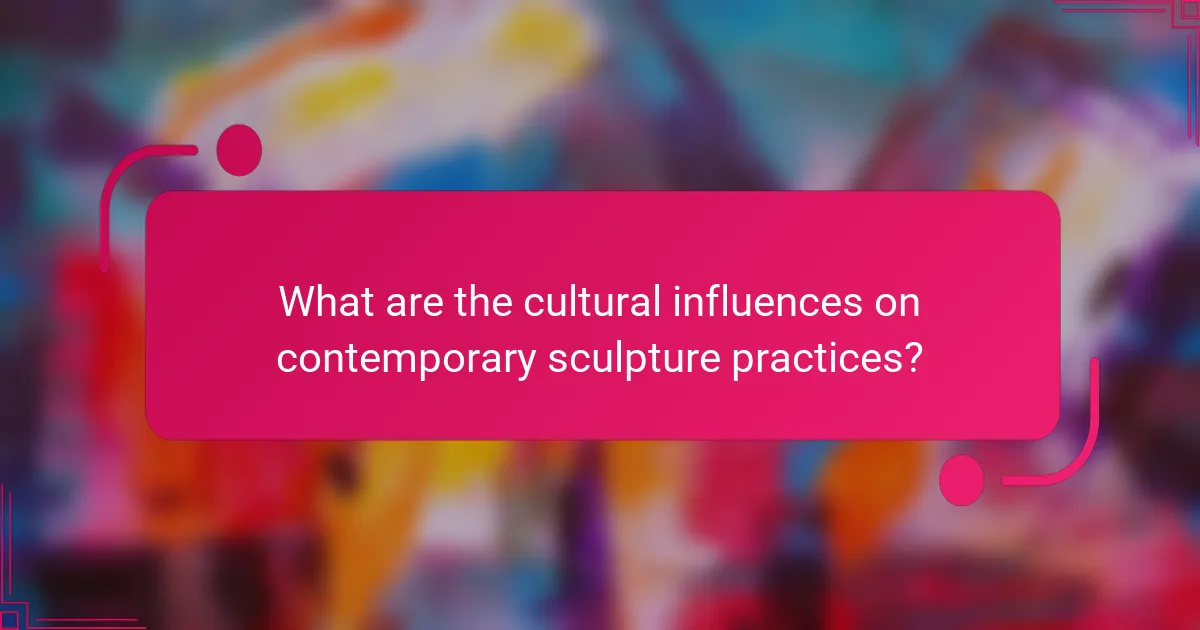
What are the cultural influences on contemporary sculpture practices?
Cultural influences on contemporary sculpture practices are diverse and significant. Globalization has facilitated the exchange of ideas, leading to hybrid forms that incorporate various cultural elements. Artists often draw inspiration from their heritage, social issues, and environmental concerns, reflecting a wide range of perspectives.
The use of materials is influenced by cultural contexts; for instance, traditional materials like clay or stone may be combined with modern elements such as recycled plastics. This integration showcases a unique attribute of contemporary sculpture, emphasizing sustainability and innovation.
Moreover, contemporary sculpture often engages with technology and digital media, expanding the definition of sculpture itself. Artists utilize virtual reality and 3D printing, demonstrating rare attributes that challenge conventional boundaries.
Finally, public art initiatives and community involvement play a crucial role in shaping contemporary practices. These projects foster dialogue and engagement, highlighting the social dimension of sculpture in urban environments.
How do regional styles manifest in contemporary sculpture?
Regional styles manifest in contemporary sculpture through the use of local materials, cultural themes, and traditional techniques. Artists often draw inspiration from their heritage, incorporating distinct forms that reflect their geographical context. For example, sculptures in Africa may utilize wood and stone, showcasing ancestral motifs, while European artists might blend modernist approaches with classical influences. This fusion creates a dialogue between the past and present, allowing for unique interpretations of cultural identity. Additionally, the global exchange of ideas has led to hybrid forms, where regional characteristics merge with contemporary practices, enriching the art form.
What cultural narratives are explored through contemporary sculptures?
Contemporary sculptures explore narratives of identity, society, and environment through innovative forms and materials. Artists challenge traditional boundaries, using diverse media to reflect cultural dialogues. For instance, installations often address social justice themes, while abstract works may symbolize personal experiences. These sculptures invite viewers to engage with complex concepts like globalization and sustainability, making them relevant in today’s cultural landscape.
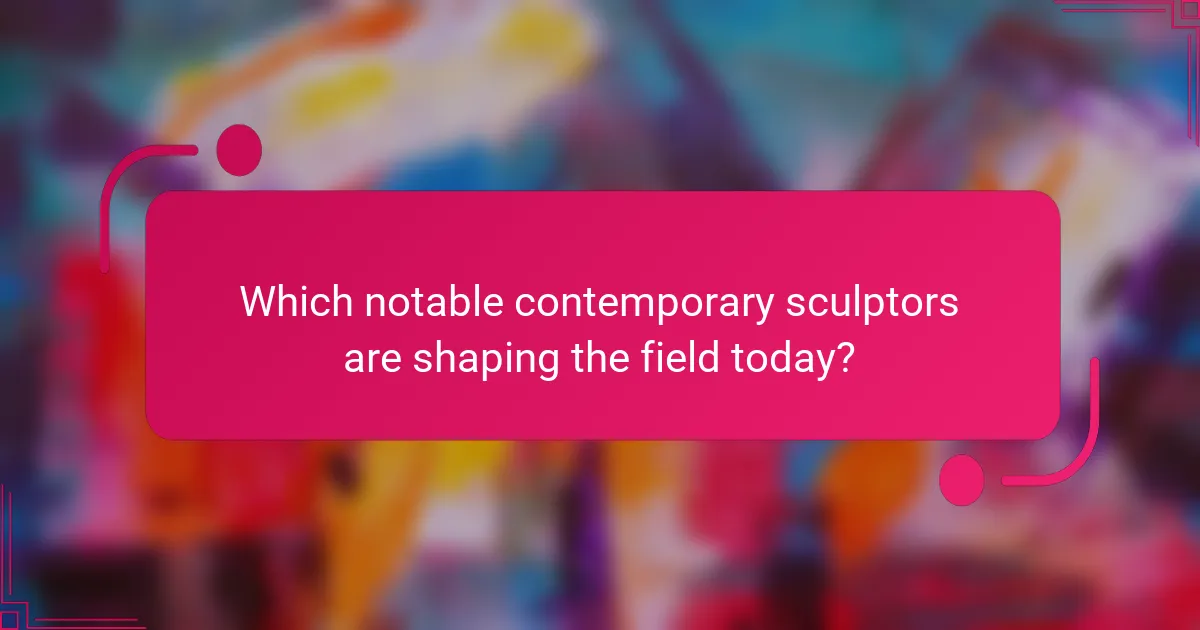
Which notable contemporary sculptors are shaping the field today?
Notable contemporary sculptors shaping the field today include Ai Weiwei, Anish Kapoor, and Tara Donovan. These artists explore innovative materials and conceptual approaches, pushing the boundaries of traditional sculpture. Ai Weiwei uses activism and social commentary in his work, while Anish Kapoor is known for his large-scale, reflective installations. Tara Donovan creates mesmerizing forms from everyday materials, showcasing the transformative power of art. Each artist exemplifies unique attributes that contribute to the evolving landscape of contemporary sculpture.
What unique contributions have specific artists made to contemporary sculpture?
Specific artists have made unique contributions to contemporary sculpture by innovating forms, materials, and conceptual approaches. Artists like Anish Kapoor challenge traditional boundaries with reflective surfaces, while Damien Hirst incorporates unconventional materials like preserved animals. Tara Donovan’s use of everyday objects creates immersive installations that explore perception. Meanwhile, Ai Weiwei’s politically charged works emphasize social commentary through sculpture. These contributions enrich the medium, pushing the limits of creativity and expression in contemporary art.
How do collaborations between artists and other disciplines enhance sculpture?
Collaborations between artists and other disciplines enhance sculpture by introducing diverse perspectives and innovative techniques. These partnerships often result in unique forms and materials that push the boundaries of traditional sculpture. For instance, collaborations with technology can integrate interactive elements, creating immersive experiences. Additionally, partnerships with performers can add a dynamic aspect to sculptural works, transforming static pieces into living art. This fusion of disciplines enriches the conceptual framework of contemporary sculpture, making it more relevant and engaging to audiences.
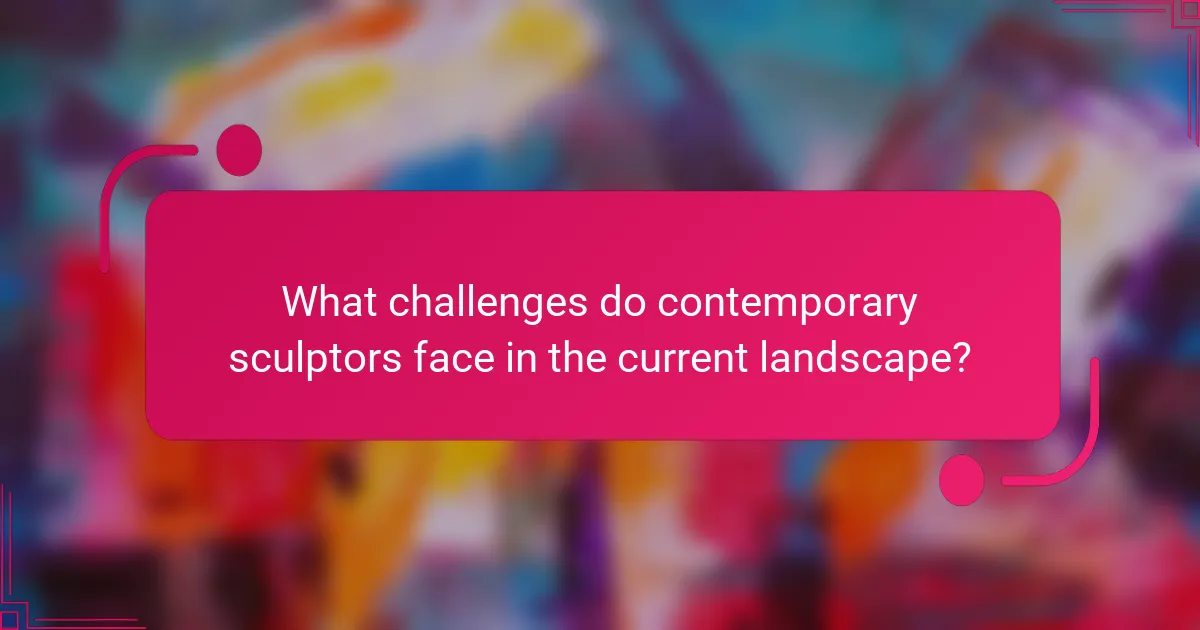
What challenges do contemporary sculptors face in the current landscape?
Contemporary sculptors face challenges such as limited funding, evolving materials, and shifting audience expectations. Economic constraints often restrict access to high-quality materials, impacting artistic expression. Additionally, the rise of digital art forms creates competition for viewer attention. Sculptors must adapt to these changes while maintaining their unique artistic voice. The integration of technology into sculpture, such as 3D printing, presents both opportunities and complexities in the creative process.
How do funding and support systems affect the production of sculpture?
Funding and support systems significantly influence the production of contemporary sculpture by providing resources and opportunities for artists. Financial backing enables artists to acquire materials and tools essential for their work. Grants and sponsorships can also facilitate larger projects that require extensive planning and execution.
Moreover, support systems, such as artist residencies and collaborative spaces, foster innovation by allowing artists to experiment with forms and conceptual approaches. These environments encourage networking and mentorship, which can enhance artistic development.
In addition, public funding initiatives often prioritize community engagement, prompting artists to create works that resonate with social issues. This connection can lead to sculptures that are not only aesthetically pleasing but also socially relevant.
Ultimately, the interplay between funding and support systems shapes the landscape of contemporary sculpture, impacting both the creative process and the final output.
What are common misconceptions about contemporary sculpture?
Common misconceptions about contemporary sculpture include the belief that it lacks traditional techniques and is purely abstract. Many assume that contemporary sculptures are solely made from modern materials, overlooking the diverse range of forms and mediums utilized. Additionally, there is a tendency to think that contemporary sculpture is inaccessible or elitist, while in reality, it often engages with social issues and invites public interaction. Another misconception is that contemporary sculptures are transient, failing to recognize the lasting impact of many installations and their role in cultural dialogue.
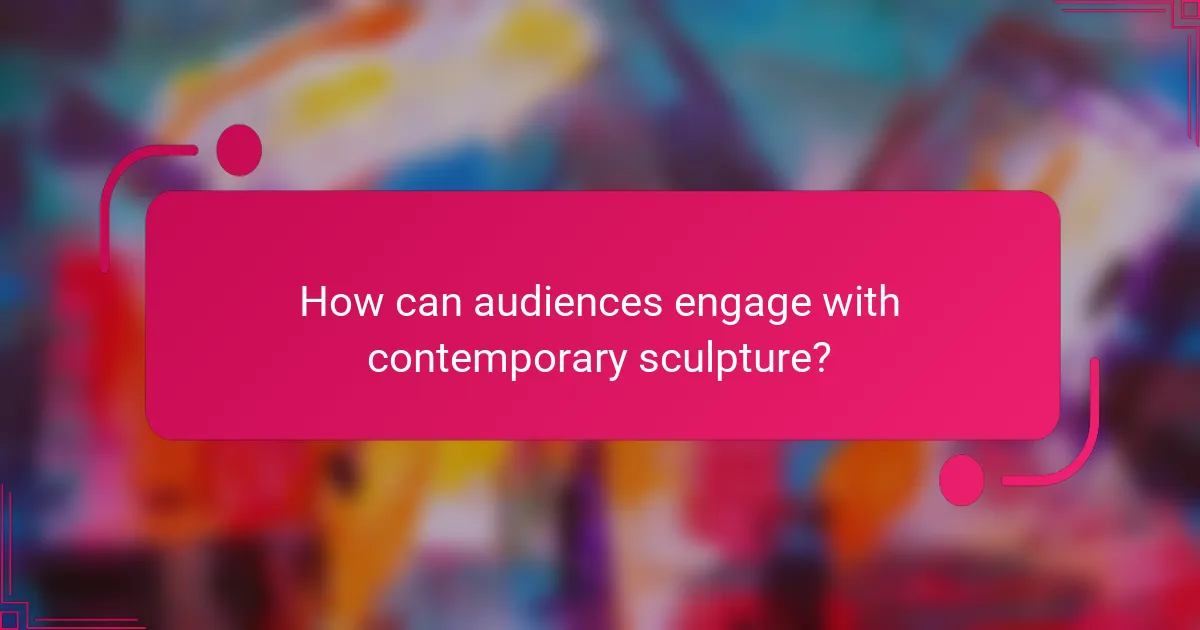
How can audiences engage with contemporary sculpture?
Audiences can engage with contemporary sculpture through interactive installations, artist talks, and community workshops. These methods foster connection and understanding of the concepts behind the artwork.
Interactive installations invite participation, allowing viewers to physically interact with the sculpture. Artist talks provide insight into the creative process and the themes explored in the work. Community workshops encourage collaboration and hands-on experience, deepening appreciation for contemporary practices.
Additionally, social media platforms enable audiences to share their experiences and interpretations, creating a broader dialogue around contemporary sculpture. This engagement enriches the cultural landscape and supports artists in their endeavors.
What are effective ways to appreciate and critique contemporary sculptures?
To appreciate and critique contemporary sculptures effectively, engage with their forms, materials, and conceptual approaches. Analyze the use of space and how the sculpture interacts with its environment.
Consider the materials chosen by the artist, as they often convey deeper meanings. For instance, recycled materials can reflect sustainability themes. Evaluate the conceptual intent behind the work, questioning the message or emotion the artist aims to communicate.
Incorporating personal feelings and thoughts can enrich your critique. Discuss how the sculpture resonates with you or challenges your perceptions. Observing the craftsmanship and technical execution can also provide insight into the artist’s skill and vision.
Lastly, contextualize the sculpture within the broader contemporary art movement. Understanding trends and influences can enhance your appreciation and critique of the work.
How do exhibitions and installations enhance public interaction with sculpture?
Exhibitions and installations enhance public interaction with sculpture by creating immersive experiences that engage viewers. These environments encourage exploration and participation, allowing audiences to connect with the artwork on a personal level.
Interactive installations often incorporate technology, enabling visitors to influence or alter the sculpture’s presentation. This dynamic aspect fosters a sense of ownership and involvement, making the art more accessible.
Additionally, exhibitions can contextualize sculptures within thematic narratives, deepening the audience’s understanding of the artist’s intent. This contextualization can highlight unique attributes of the sculptures, such as their materiality or conceptual frameworks, enhancing appreciation.
Public engagement is further amplified through community events and workshops held in conjunction with exhibitions. These activities invite diverse audiences to experience sculpture in new ways, promoting dialogue and interaction among participants.
What best practices should emerging sculptors follow to succeed in the field?
Emerging sculptors should focus on developing a unique style, mastering materials, and building a strong network. They must continuously experiment with forms and concepts to innovate within contemporary sculpture. Engaging with the art community, attending workshops, and showcasing work in exhibitions are essential for visibility. Understanding market trends and audience preferences can help sculptors align their creations with demand. Finally, leveraging social media for promotion can significantly enhance their reach and connection with potential buyers.
